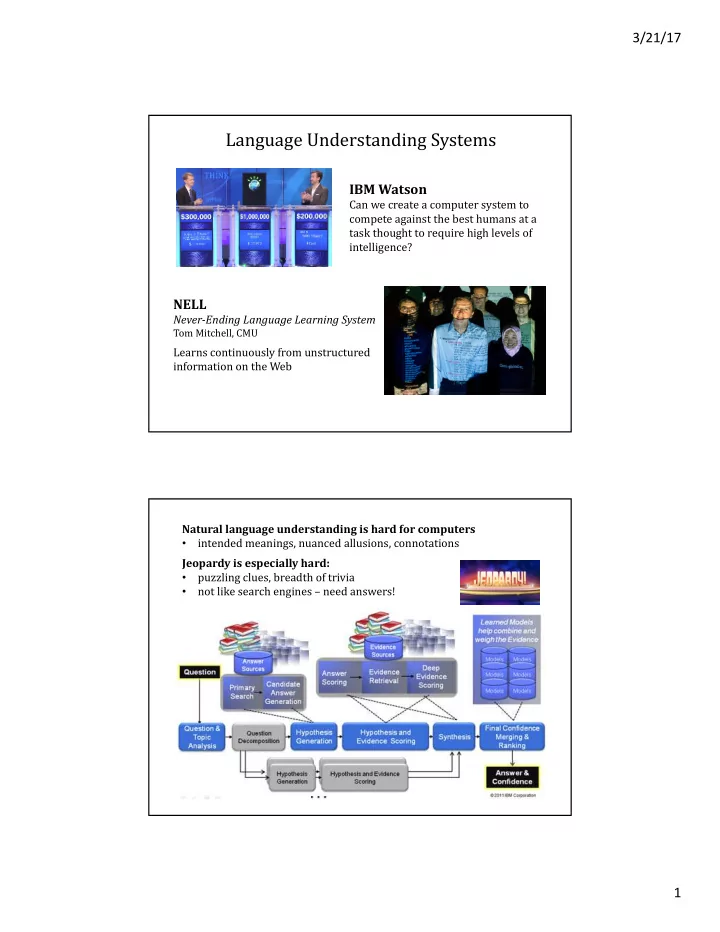

3/21/17 Language Understanding Systems IBM Watson Can we create a computer system to compete against the best humans at a task thought to require high levels of intelligence? NELL Never-Ending Language Learning System Tom Mitchell, CMU Learns continuously from unstructured information on the Web Natural language understanding is hard for computers • intended meanings, nuanced allusions, connotations Jeopardy is especially hard: • puzzling clues, breadth of trivia • not like search engines – need answers! 1
3/21/17 DeepQA Architecture Made possible by advances in computer speed, memory • Early implementation ran on a single processor, took 2 hours to answer a single question • Now scaled up to over 2,500 computer cores, IBM servers, reduced the time to about 3 seconds Massive parallelism: • considers many interpretations/hypotheses simultaneously Many experts: facilitate integration, application, contextual evaluation of wide range loosely • coupled probabilistic question and content “experts” Pervasive confidence estimation: no one component commits an answer, all produce features and associated • confidences, scoring different question and content interpretations Confidence Profile from Many Factors 2
3/21/17 The Outtakes... Category: “Letters” Clue: “In the late 40s a mother wrote to this artist that his picture Number Nine looked like her son’s finger painting” Correct answer: “Jackson Pollock” Watson’s answer: “Rembrandt” Reason: Watson failed to recognize that “late 40s” referred to the 1940s Category: “U.S. City” Clue: “Its largest airport is named for a World War II hero, its second largest for a World War II battle” Correct answer: “Chicago” Watson’s answer: “Toronto” Reasons: (1) by studying previous competitions, Watson “learned” to pay less attention to the category part of the rule (2) Watson knew that a Toronto team is in the U.S. baseball league, and one of Toronto’s airports is named for a WWI hero Question: Can we create a computer system to compete against the best humans at a task thought to require high levels of intelligence? Some of Watson’s legacy: • great piece of engineering remarkable performance (not thought possible at outset) • • re-ignited public interest in Artificial Intelligence • new technology with broad applications But ... • IBM has not created a machine that thinks like us • Watson’s success does not bring us closer to understanding human intelligence • Watson’s occasional blunders should remind everyone that this problem is still not solved 3
3/21/17 NELL: Never-Ending Language Learner “We will never truly understand machine or human learning until we can build computer programs that, like people, • learn many different types of knowledge or functions, • from years of diverse, mostly self-supervised experience, • in a staged curricular fashion, where previously learned knowledge enables learning further types of knowledge, • where self-reflection and the ability to formulate new representations and new learning tasks enable the learner to avoid stagnation and performance plateaus.” Mitchell et al., AAAI, 2015 Natural language understanding requires a belief system • I understand, and already knew that • I understand, and didn’t know, but accept it • I understand, and disagree because ... “ NELL: Never-Ending Language Learner Inputs: • initial ontology with hundreds of categories and relations to “read about” on the web • categories , e.g. person, sportsTeam, fruit, emotion • relations , e.g. playsOnTeam(athlete,sportsTeam) playsInstrument(musician,instrument) • 10-15 examples of each category and relation • the web (~ 500 million webpages + access to search engines) The task: • run continuously, forever • each day: 1) extract new instances of categories and relations (noun phrases) 2) learn to read (perform step (1)) better than yesterday 4
3/21/17 http://rtw.ml.cmu.edu/rtw Early Work – Simple “Bootstrap” Learning Learn which noun Too unconstrained! phrases are cities: anxiety Paris San Francisco selfishness Pittsburgh Berlin London Seattle denial Montpelier (known) <arg> is home of traits such as <arg> mayor of <arg> live in <arg> Learn based on multiple cues simultaneously , e.g.: (1) distribution of text contexts (appear in phrases with the same words) (2) same features of character string (e.g. capitalized, ends with “... burgh”) 5
3/21/17 Coupling of Categories & Relations NELL is simultaneously trying to learn: (1) which noun phrases refer to which categories (2) which noun phrases participate in which relations NELL knows: (1) constraints between categories e.g. athletes must be people, sports cannot be people (2) constraints on categories for relations e.g. playsSport(athlete,sport) athlete(NP) à person(NP) athlete(NP) à NOT sport(NP) sport(NP) à NOT athlete(NP) Use expanded knowledge base to “re-train” classifiers Read web pages to find new candidate beliefs (classify instances of categories and relations) Further learning by NELL: (1) new constraints between relations: if (athlete X plays for team Z) and (team Z plays sport Y) then (athlete X plays sport Y) (2) new relations: <musical instrument> master <musician> <mammals> eat <plant> (3) new subcategories, e.g. pets, predators (subcategories of animal) 6
3/21/17 Learns new relations from frequent co-occurrences of instances of two categories ... ... but humans have veto power! 7
Recommend
More recommend